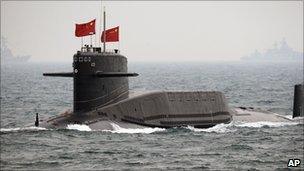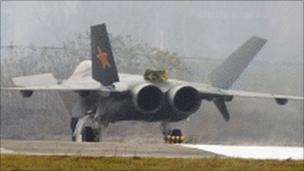China military 'closing key gaps', says Pentagon
- Published

China's military power is keeping pace with its growing economic dominance
China is on course to build a modern military by 2020, a move that could threaten stability in the Asia-Pacific region, the Pentagon says.
In its annual report on China's defence capability, the Pentagon said China had closed key technological gaps.
A main aim of the military development was to prevent possible US intervention in any conflict with Taiwan, it said.
China said the US report had exaggerated the threat posed by its military, calling it "cock-and-bull".
The report, external comes in a year in which China conducted both the first test-flights of its new J20 stealth aircraft and sea trials of its new aircraft carrier.
'Anxieties'
Launching the report, Deputy Assistant Secretary of Defence for East Asia Michael Schiffer said that the pace and scope of China's military investments had "allowed China to pursue capabilities that we believe are potentially destabilising to regional military balances, increase the risk of misunderstanding and miscalculation and may contribute to regional tensions and anxieties."

In January, China held its first test flight of the J20 stealth fighter jet
The new capabilities could tempt Beijing to use military force to resolve disputes in its favour, he said.
But he said that at present China's ability to sustain military power at a distance remained limited.
According to the report, defence experts do not expect the J20 stealth fighter to achieve "effective operational capability prior to 2018".
Mr Schiffer said that while the aircraft carrier - a former Soviet vessel that China has refurbished - could become operational by late 2012, it would be some years before aircraft could be stationed on it.
But China could begin construction on a home-grown carrier this year, the report added.
The report also flagged up advances in China's space and cyber operations, saying it was "developing a multi-dimensional programme to improve its capabilities to limit or prevent the use of space-based assets by adversaries during times of crisis or conflict".
It said that in 2010, numerous computer systems including those of the US government were the target of intrusions "focused on exfiltrating information" that appeared to have originated from within China.
The report said that while China's military was focusing on a "growing array of missions", Taiwan remained its main strategic direction.
"In pursuit of this objective, Beijing is developing capabilities intended to deter, delay, or deny possible US support for the island in the event of conflict," it said.
The report noted the need for stronger US-China military ties. Contacts were frozen in 2010 by Beijing in protest at a US arms sale to Taiwan.
And it said that although China had become slightly more transparent about its military spending, many uncertainties remained.
'Cherish ties'
China criticised the US report as an exaggeration.
"It is weird that the Pentagon, whose expenditures reached nearly $700bn and accounted for over an appalling 40% of the world's total in 2010, routinely points its finger at China, whose military only spends a small fraction of what the Pentagon consumes every year," said a commentary in state-run Xinhua news agency, external.
China said in March it planned to increase defence spending in 2011 by 12.7% to 601.1bn yuan ($91.5bn; £56.2bn), but some analysts believe the total is far higher.
China had every right to build a competent military and its "so-called advanced weapons" under development were items that other countries already had, the commentary pointed out.
"The two countries should cherish their hard-won improved bilateral ties, particularly the military relations, instead of blaming and smearing each other," the commentary said.
- Published10 August 2011
- Published8 June 2011
- Published4 March 2011
- Published11 January 2011